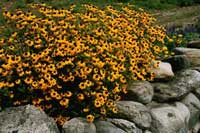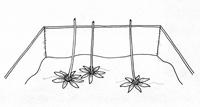Using Black Eyed Susans in the Landscape
Black-eyed Susans are very showy during the period that they are in bloom, so they stand out in the summer garden. Plant some in the yard to brighten areas where evergreen shrubs dominate. Place them toward the back of a flower bed so that they do not overwhelm smaller plants. Plant them in corners where other plants have difficulty because of poor soil or along walls, fences and in niches that need a splash of color. In large spaces, several clumps planted closely create stunning drifts of golden yellow. While not suitable for windowboxes and smaller containers, Black-eyed Susans will grow enthusiastically in large pots on decks and patios. Be sure to water them regularly, as plants in pots located in bright summer sun dry out rapidly.
 |
Drying
Black-eyed Susans are among the easiest flowers to dry with sand or borax. Pick dry flowers on a clear, low humidity day after dew has dried and before evening dampness. Choose perfect flowers with no holes in the petals or discoloration. Plunge cut stems into warm water immediately to forestall wilting.
Use very fine, clean sand. Place flowers in a container such as a shoe box set face down with their stiff stems vertical. Gently pour sand in and around the blossoms, filling the container and covering the petals completely. Leave the box uncovered to encourage moisture evaporation and provide air circulation. Sand doesn’t desiccate plant tissues, it just supports the flower while it dries naturally.
It will take 3 to 5 weeks, depending on thickness of the petals and the dryness of the atmosphere. An alternative to sand is a medium of 1 part borax to 3 or 4 parts cornmeal. You can also choose to air dry the blossoms, allowing the petals to drop, and keep the black bristly seedheads.
Common Challenges When Using Black-Eyed Susans
1. How Do You Dry Black-Eyed Susans?
Drying Black-Eyed Susans is simple and can be done in a few ways, depending on your preference:
Bundling and Hanging
- Gather 15 or more stems of Black-Eyed Susans and tie them tightly with twine.
- Hang the bundle upside down in a dry, dark space with good airflow.
- Re-tie the stems if they shrink. The flowers will fully dry in 2–3 weeks.
Face-Up Drying
- Place the blooms face-up on a mesh surface, like chicken wire, to support the petals.
- Leave them in a dry, well-ventilated area to preserve their shape as they dry naturally.
Evaporation Method
- Put the stems in a jar with a small amount of water (1–2 inches).
- Allow the water to evaporate over time. This method works best in dry climates.
Whether you prefer drying black eyed susans by hanging, laying them flat, or using the evaporation method, these techniques preserve their beauty for decorative use. Once dried black eyed susans are ready, they make stunning additions to crafts and arrangements.
2. How Do You Dry Black-Eyed Susans?
Drying Black-Eyed Susans is an easy process, and you can choose from several methods based on your needs and preferences.
Here’s how to do it:
One popular method is bundling and hanging, where you gather 15 or more stems and tie them tightly with twine. Leave some extra twine to create a loop for hanging. Hang the bundle upside down in a dark, dry space with good airflow. Check the stems occasionally, as they may shrink and require re-tying. This method typically takes 2–3 weeks to fully dry the flowers.
Another option is face-up drying, which helps preserve the shape of the petals. To do this, place the flowers face-up on a supportive surface like chicken wire or a fine mesh sieve. Leave them in a well-ventilated, dry area to naturally dry over time.
If you prefer a more gradual process, try the evaporation method. Place the stems upright in a jar with about 1–2 inches of water. Over time, the water will either evaporate or be absorbed by the stems, leaving the flowers dry. This works best in areas with low humidity.
Transforming black eyed susans into dried keepsakes adds a timeless touch to your home. By using techniques like hanging, flat drying, or the evaporation method, you can preserve their natural beauty. These dried black eyed susans are perfect for crafts, arrangements, or simply as a cherished reminder of their golden summer blooms.
3. Can Black-Eyed Susans Grow in Pots?
Yes, Black-Eyed Susans can grow in pots and thrive when provided with the right conditions. They’re a great option for patios, decks, or small spaces. Here’s what you need to know:
- Pot Size: Use a large pot, ideally one gallon or larger. Bigger containers support their deep roots and help the plants grow larger with more blooms.
- Soil: Choose well-draining, nutrient-rich potting soil. Adding materials like gravel at the bottom can improve drainage.
- Sunlight: Place the pot in full sun, as Black-Eyed Susans perform best with 6–8 hours of direct sunlight daily.
- Watering: Keep the soil evenly moist, but avoid overwatering. Daily watering may be necessary in hot weather.
- Fertilizing: Feed the plants with a balanced fertilizer once a year in spring to encourage healthy growth.
- Winter Care: In colder climates, move the pots to a sheltered area, such as an unheated garage or basement, to prevent the soil from freezing.
With proper care, Black-Eyed Susans in containers can brighten any space and provide stunning blooms throughout the season.
Fascinating Facts About Black-Eyed Susan Flowers
Black Eyed Susan flowers (Rudbeckia hirta) are native to North America and are often considered a symbol of encouragement and motivation. Their bright yellow petals and dark centers make them one of the most recognizable wildflowers, and they are the official state flower of Maryland! These flowers are also loved by pollinators, attracting bees, butterflies, and birds to gardens.

